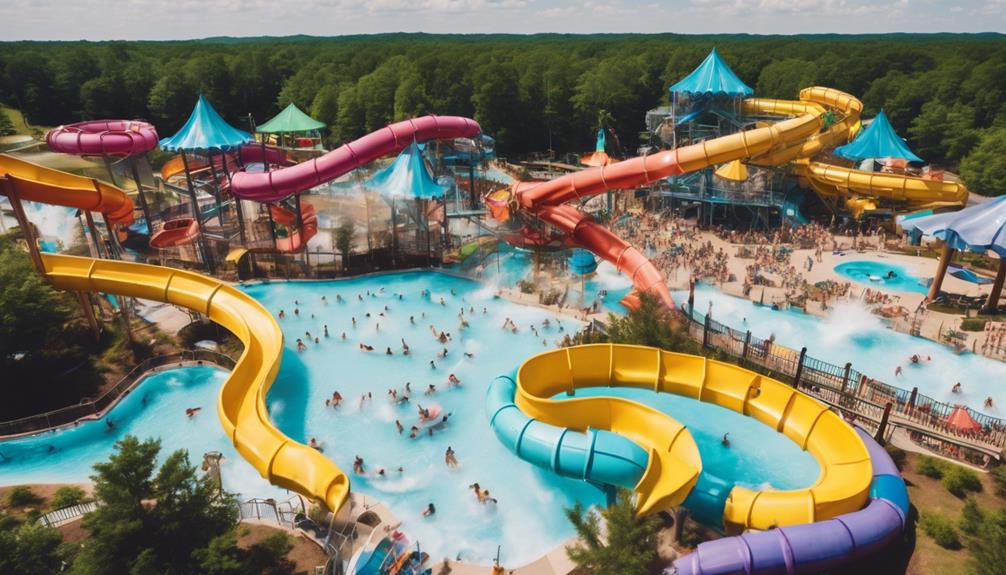Creating top-tier parks with accessibility excellence means designing inclusive spaces where everyone can participate easily. You should guarantee pathways are wide, smooth, and include gentle slopes with resting spots. Incorporate accessible play areas with ramps and sensory features, and provide accessible restrooms, water fountains, and parking. Good lighting, clear signage, and obstacle-free routes enhance safety and navigation. Continuing further, you’ll discover key standards and practical tips to make your park welcoming and usable for all visitors.
Key Takeaways
- Adhere to established accessibility standards ensuring safe, navigable pathways, inclusive play areas, and accessible amenities for all visitors.
- Design wide, smooth, and gently sloped pathways with tactile signage and auditory cues to accommodate diverse mobility and sensory needs.
- Incorporate inclusive play equipment with ramps, textured surfaces, and sensory zones to enable full participation for children with various abilities.
- Provide accessible facilities such as restrooms, water fountains, parking, and lighting that meet universal design principles.
- Prioritize safety and visibility through proper lighting, clear signage, and features that foster a welcoming, inclusive environment for all users.

Ensuring parks are accessible to everyone is essential for fostering inclusive communities. When you design parks with accessibility in mind, you create spaces where people of all abilities can enjoy nature, recreation, and social connection. It’s about removing barriers that prevent participation, whether they’re physical, visual, or cognitive. By adhering to established accessibility standards, you guarantee that every visitor can navigate the park comfortably and safely, making the experience welcoming and inclusive. Incorporating cost considerations into planning ensures that accessible features are sustainable and fit within the community’s budget. Start by considering the layout of pathways and trails. These should be wide enough to accommodate wheelchairs, strollers, and mobility devices comfortably. Smooth, firm surfaces are crucial; avoid gravel or uneven terrain that can hinder movement. Incorporate gentle slopes with appropriate handrails and resting spots along longer inclines so users can take breaks if needed. Clear signage with high contrast, large fonts, and tactile elements helps visitors with visual impairments navigate confidently. You might also include auditory cues or descriptions for key features, ensuring that everyone can access information about the park’s amenities and features.
Play areas should be inclusive, designed to allow children with diverse abilities to participate fully. Install equipment accessible to children with mobility challenges, such as ramps leading to swings or seated play structures. Use contrasting colors and textured surfaces to help children with visual impairments identify different zones. Seating areas with shade and comfortable surfaces encourage caregivers to relax while children explore. Consider sensory-rich zones that stimulate different senses, making play accessible to children with various cognitive and sensory needs.
Restrooms and water fountains must meet accessibility standards. Restrooms should include wide doors, grab bars, and enough space for wheelchair maneuverability. Position water fountains at heights accessible to all users, including those in wheelchairs, and incorporate features like touchless operation to reduce barriers. Parking areas should also be accessible, with designated spaces close to park entrances, wide enough for various vehicles, and clearly marked with signage. Pathways from parking to key areas need to be direct, well-maintained, and free of obstacles.
Lighting plays a vital role in safety and accessibility, especially in the evening. Ensure pathways are well-lit, and features like benches and signage are visible and easy to find in low-light conditions. Incorporating accessible features isn’t just about compliance; it’s about fostering a sense of belonging and ensuring everyone can enjoy the benefits of outdoor spaces. When you prioritize inclusive design, you help create parks that truly serve the entire community, encouraging participation and connection for all visitors.
Frequently Asked Questions
How Are Accessibility Standards Updated to Reflect New Technologies?
You stay informed by regularly reviewing updates from industry organizations and tech innovators. You participate in workshops and conferences to learn about new accessibility tools and methods. You collaborate with experts and users to gather feedback on emerging technologies. By integrating user-centered testing and monitoring technological advancements, you guarantee your standards evolve promptly. This proactive approach keeps your parks inclusive, leveraging the latest innovations for a better visitor experience.
What Training Do Staff Receive on Inclusive Park Design?
Did you know that 85% of park staff report feeling less confident in inclusive design? You receive specialized training on inclusive park design, which covers universal accessibility principles, assistive technology, and community engagement. This hands-on learning helps you better serve diverse visitors, ensuring parks are welcoming for everyone. Ongoing workshops and certification programs keep your skills sharp, making sure you stay updated on the latest inclusive design standards.
How Is Feedback From Disabled Visitors Incorporated Into Park Improvements?
You receive feedback from disabled visitors through surveys, comment cards, and direct conversations. This input is actively examined by the park’s accessibility team, who prioritize improvements based on visitor needs. Your suggestions lead to tangible changes, like better signage, smoother pathways, and accessible amenities. By continuously listening and adapting, the park ensures an inclusive environment where everyone feels valued and accommodated, making every visit enjoyable.
Are There Specific Funding Sources for Accessible Park Features?
Yes, there are specific funding sources for accessible park features. You can explore government grants, such as those from the Department of Housing and Urban Development or local transit authorities, which often support accessibility projects. Additionally, private foundations and nonprofit organizations dedicated to inclusive design may offer funding opportunities. Securing these funds can help you enhance park accessibility, ensuring that everyone, regardless of ability, enjoys the outdoor space.
How Do Parks Measure the Success of Their Accessibility Initiatives?
You measure your park’s accessibility success through visitor feedback, usage data, and achievement of set goals. Conduct surveys and observe how diverse groups interact with features to identify improvements. Track the number of visitors with disabilities engaging with your amenities, and compare these figures over time. Regularly review your initiatives against accessibility standards, modifying your strategies to guarantee inclusivity, so everyone can enjoy the park fully.
Conclusion
By embracing inclusive design, you become the guiding light that illuminates every corner of the park, ensuring no one feels left behind. Your commitment transforms the space into a beacon of hope, where barriers crumble like fading shadows. When you prioritize accessibility, you’re planting seeds of unity and joy, nurturing a garden where everyone can flourish. Together, you create a sanctuary of belonging—a symbol that true beauty lies in openness and shared experience.









